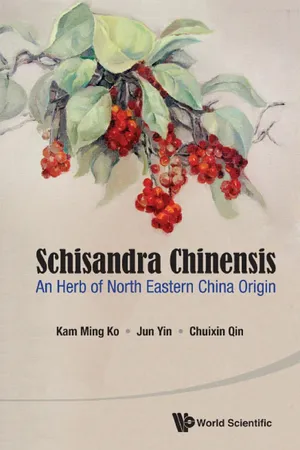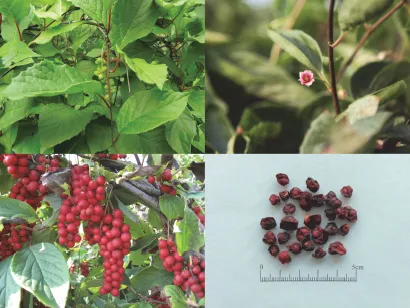![]()
1
Plant Origin and Resources, Cultivation and Farming Technology, Production and Processing of Schisandrae Fructus
Dong-Xue Sun, Jing Wang [Translated by Kam-Ming Ko]
Schisandrae Fructus [the fruit of Schisandra chinensis (Turcz.) Baillon; also called Wu-wei-zi in Chinese] is a widely used Chinese herb. In the practice of Chinese medicine, Schisandrae Fructus is prescribed for inducing astringency, supplementing Qi, promoting the production of body fluids, tonifying the kidney and calming the heart. It is a well-known Chinese Materia Medica that is mostly produced in Northeast China, with an annual market demand of more than 2000 tons. Furthermore, the dried ripened fruit of Schisandra sphenanthera (Huazhong Wu-wei-zi) can also be used as a medicinal herb, similar to Kadsura longepedunculata (Nan Wu-wei-zi). Other species in the Schisandraceae family are also used as substitutes for Schisandrae Fructus. This chapter, which describes the plant origin, synonymies, herbal history, geographical distribution, cultivation and farming technology, as well as the production and processing of Schisandrae Fructus, provides a wealth of information for agricultural production and commercial application of this herb in the future.
1.1 Plant Origin and Herbal History
In editions of the Chinese Pharmacopoeia published before 2000, the dry ripened fruit of both Schisandra chinensis (Turcz.) Baillon and Schisandra sphenanthera Rehd. et Wils were referred to as Schisandrae Fructus, but later experimental and clinical research showed that the two Schisandra species are slightly different in terms of their chemical composition as well as their therapeutic effects. Therefore, in editions of the Chinese Pharmacopoeia published after 2000, the two species of Schisandra have been denoted Schisandrae Fructus (Bei Wu-wei-zi) and Kadsura Fructus (Nan Wu-wei-zi), respectively. Given the existence of persisting confusion regarding Wu-wei-zi, we will describe the plant origin, herbal history and plant resources of various Schisandra species.
1.1.1 Plant origin and synonymies
Schisandrae Fructus is the dry ripened fruit of Schisandra chinensis (Turcz.) Baillon. In Chinese, Schisandrae Fructus is also called Xuan-ji, Hui-ji, Shan-hua-jiao, Zhuang-wei, Wu-wei, Mian-teng-zi, Xue-teng-zi, Wu-mei-zi, Bei Wu-wei-zi, Bei Wu-wei, Liao Wu-wei, Liao Wu-wei-zi or Wu-mei-zi.
1.1.1.1 Plant origin
Schisandra chinensis is a deciduous woody climbing plant that can grow up to 8 m with brown branchlets. The simple alternating leaves (5–11 cm long and 3–7 cm wide) are oval, wide reversed oval, or wide and elliptical in shape, with extremely sharp tips and a wedged base. Leaf margins have glandular serrulate, with no hair on the surface. Its unisexual flowers are dioecious and rarely monoecious; solitary or in clustering axillae, with 6–9 milky white or pink tepals. The male flower has 5 stamens, while anthers cluster on the top of the cylindrical receptacle; the female flower has 17–40 carpels, and the receptacles prolong after flowering; the ripened fruits aggregate like a spike. The bacca is round, fleshy, and dark red in color after ripening. The flowering stage starts from May to July, while the fruiting stage from June to September. The plant is shown in Fig. 1-1.
1.1.1.2 Herbal history
Schisandrae Fructus was first recorded in the Shennong’s Herbal Classic as an herb with both sour and sweet taste. The herb is listed as a top-grade herb and can be used for supplementing Qi, coughing out the reversed ascending Qi, treating internal lesions, supplementing body deficiency, strengthening Yin and replenishing male essence. While the plant is grown in valleys, the herbs with the best quality are produced from Koryo (now in North Korea), which possesses sufficient pulp and sour/sweet taste, as recorded in the Annotations to Shennong’s Herbal Classic by Tao Hongjing. The second best plant is grown in Qingzhou (now in Shandong) and Jizhou (now in Henan), with a much more sour taste and kidney-shaped seeds. Schisandrae Fructus is also produced in Jianping (now in Poyang Lake of Jiangxi), with little pulp, irregularly-shaped seeds and a bitter taste. The plant encroaches on trees and its leaves are as large as those of apricot, and its seeds resemble those of sunflowers in shape and size. As annotated in the Tang Materia Medica by Su Gong, Schisandrae Fructus is also grown in Puzhou (now in Shanxi) and Lantian Mountain (now in Lantian county of Shanxi). According to the Shu Materia Medica (or the Revised Materia Medica), the plant encroaches on trees, with red stems and yellow-white flowers; its crude seeds are green and its ripened seeds are purple in color; the fruit also has five colors and the good ones taste sweet. The Figures Annotated Chinese Materia Medica noted that the plant is mainly grown in Shanxi of Hedong (now in Shanxi, Gansu and Inner Mongolia), followed by Hanzhou and Yuezhou (now in Hangzhou and Jiangsu); it sprouts in early spring and encroaches on high trees; it can grow to seven feet long, with sharp round leaves like apricot leaves; it produces white-yellow flowers in March and April, like the lotus flower. The aforementioned information was repeatedly quoted in the Reversion of Materia Medica Backup in Politics and History. The Compendium of Materia Medica by Li Shizhen stated that the plant is grown in Southern China (red) and Northern China (black), and the black colored plant is better used for promoting health (i.e., nourishing or tonifying the body function).
Fig. 1-1. The plant of Schisandra chinensis (Tucrz.) Baillon.
According to all of the literature on Chinese Materia Medica, Korea and Northeast China, Hebei and Shandong are consistently regarded as the major geographical locations for growing Schisandra chinensis (Turcz.) Baillon, whereas Shanxi, Gansu, and Zhejiang are major growing areas for Kadsura longepedunculata, whose original plant is Schisandra sphenanthera Rehd. et Wils. According to the colors of the fruits (i.e. the herb portion), Li Shizhen classified Wu-wei-zi into Kadsurae Fructus (the fruit of Kadsura longepedunculata or Schisandra sphenanthera) and Schisandrae Fructus (the fruit of Schisandra chinensis), with the latter being considered superior in promoting health.
1.1.1.3 Ecological habitat and major growth areas in China
The wild plant of Schisandrae Fructus grows in conifer broadleaf forests, valleys, stream banks, small trees and bushes, forest edges, or open places in forests. The plant encroaches on other trees. The wild plant grows in wet environments; it cannot resist low-lying water or immersion, but it resists cold; sun exposure should be avoided at the seedling stage. The plant grows in acidic, deep and loose sandy loam with rich humus and high fertility.
Schisandrae Fructus is mainly cultivated in Xiuyan, Xifeng, Qingyuan, Xinbin, Fushun, Anshan, Benxi, Fengcheng, Huanren and Dandong of Liaoning Province, and in Wuchang, Shangzhi, Fangzheng, Yichun, Mudanjiang, Ning’an, and Mishan of Heilongjiang Province, as well as in Jilin, Hebei, Inner Mongolia, Shandong, Shanxi, Shaanxi, and Ningxia Provinces. In general, Schisandrae Fructus produced from Liaoning possesses desirable characteristics such as high oil content, purple and thick pulp and a strong taste. Hence, it is therefore highly regarded as Liaowuwei (i.e., Schisandrae Fructus from Liaoning).
1.1.2 Plant resources
Schisandraceae belongs to Magnoliidae Illiciales which includes two genera viz. Schisandra Michx. and Kadsura Kaempf. ex Juss. The gynoecium of Schisandra Michx. has a cylindrical or conical receptacle, which extends prominently during the development stage; the aggregate fruits are spikeshaped. The gynoecium of Kadsura Kaempf. ex Juss. has an obovoid or elliptical receptacle, which does not extend at the development stage; the aggregate fruits are spherical or elliptical. Schisandra Michx. includes 23 species worldwide and is randomly distributed in East Asia and North America. There are 19 species in China, which are distributed in both northern and southern regions. Kadsura Kaempf. ex Juss. includes 16 species which are widely distributed in Asia, especially in Southern China. There are 10 species in China, which are distributed from Southeastern to Southwestern regions.
1.1.3 Classification of Schisandraceae
Schisandra chinensis was traditionally assigned to the subfamily or genus of Magnoliaceae, but long-term research has shown that Schisandra sphenanthera has a chromosome number of 14, which is different from that of Magnolia or Liriodendron (n = 19 or 38) in Magnoliaceae (narrowly defined). A relationship between the chromosome number and node anatomic type may exist. The species with a chromosome number of 19 have tri-lacunar or multi-lacunar nodes, while species with a chromosome number of 14 have uni-lacunar nodes. Morphological comparison between Magnoliaceae and Schisandra Michx. has revealed that despite the resemblance to phyllotaxis, they distinctly differ in flower appendage arrangement, ovule structure, Polygonum-shaped embryo, cell-shaped endosperm, and willow herb-shaped embryo, flower structure, stamen, carpel, anther, pollen, seeds, fruits, chromosome number, and wood anatomy. Moreover, in Schisandra Michx. and Kadsura Kaempf. ex Juss., sclereids are distributed in the phloem, with crystals but not pits, while in Magnoliaceae (narrowly defined), the phloem is devoid of sclereids. These characteristics provide evidence to support the distinction between Schisandra Michx. and Kadsura Kaempf. ex Juss. from Magnoliaceae (broadly defined) and thus the formation of Schisandraceae. Thus, as recorded in China Flora, Schisandra Michx. and Kadsura Kaempf. ex Juss. constitute the family of Schisandraceae.
1.1.4 Medicinal plants from Schisandra Michx
Schisandra Michx. is comprised of woody vines, of which the petiolar base in the branchlets grow downwards at two sides to form vertical or narrow-wing-shaped stripes. They have long shoots and saw-shaped short shoots. The buds are solitarily axillary or collateral, or clustering at the axil or top of the short shoots; the buds have scales as the exterior scales remain longer, while the interior scales fall early. On the papery leaves, the marginal membrane grows down the footstalk to form a narrow wing. The flowers are unisexual, dioecious, rarely monoecious, solitary or clustering in axillary or bract axil. The flower has 5–12 (20) tepals, the middle one being the largest. The male flower has 5–60 stamens, with long or short filaments, narrow or slightly wide connectivum, and the two pollen chambers are parallel or slightly apart. The androecium is long- or short-cylindrical, ovoid, ovoid-spherical, and the pulp is spherical or oblong in shape. The female flower has 12–120 pistils, which are distinct and spirally arranged on the receptacle. The receptacle in the gynoecium extends prominently at development stage, with long-spiked aggregate fruits and small baccas. Seeds are kidney-shaped, flat-oval or flat-spherical, with obvious hila; the seed capsule is light brown in color, smooth or wrinkled or with strumae. The seeds contain rich and oily endosperm.
1.1.5 Various species of Schisandra Michx
Schisandra rubriflora
The fruits and vines are used as medicinal herbs to relieve cough and asthma as well as to resolve sputum, to treat spontaneous and night sweating, chronic diarrhea and protracted dysentery, spermatorrhea and neurasthenia, and to promote blood circulation and remove dampness (i.e. excessive water in the body). The plant grows in South Gansu, Hubei, Sichuan, Chongqing, West and Southwest Yunnan, and Southeast Tibet.
Schisandra incarnata
The fruits and stems are used as medicinal herbs to relieve cough and asthma as well as to resolve sputum, and to treat spontaneous and night sweating, chronic diarrhea, protracted dysentery, spermatorrhea, neurasthenia, and traumatic injuries. It grows in Western and Southwestern Hubei.
Schisandra sphaerandra
The fruits, roots and stems are used as medicinal herbs to relieve cough and asthma as well as to resolve sputum, and asthma, and to treat spontaneous and night sweating, chronic diarrhea, protracted dysentery, fractures, and arthritis. This plant grows in Southwest Sichuan and Northeast Tibet.
Schisandra chinensis
The fruits are used as medicinal herbs to relieve cough and asthm...

